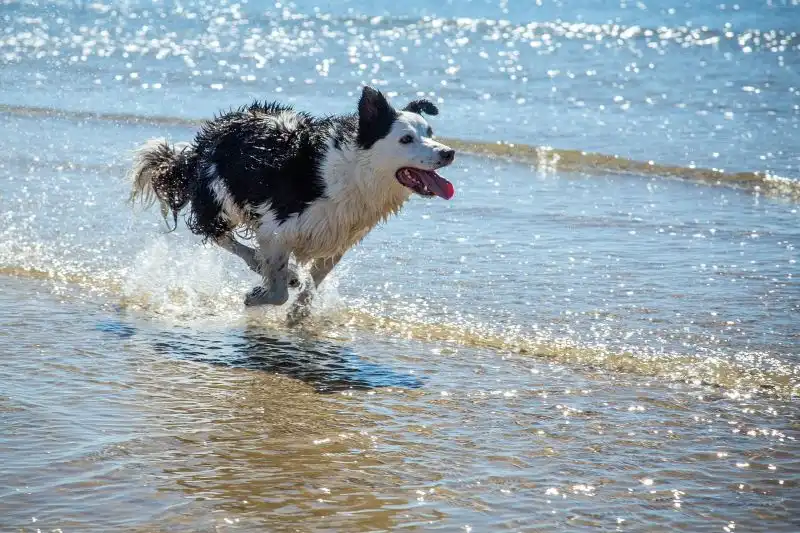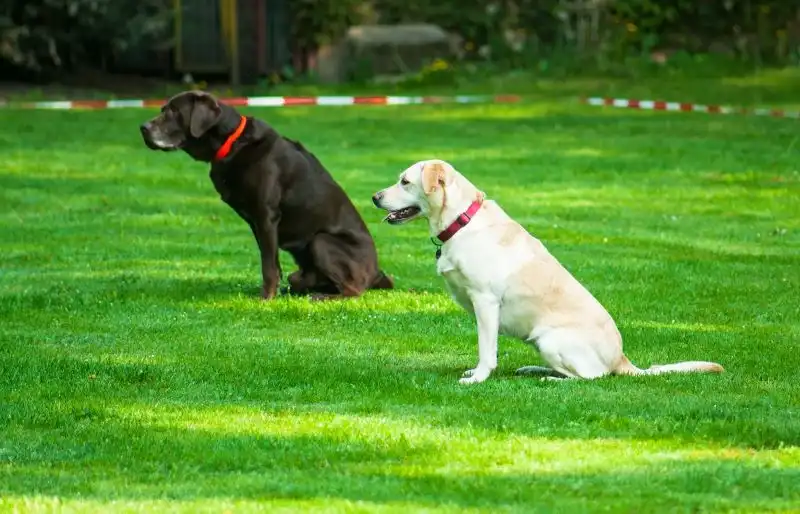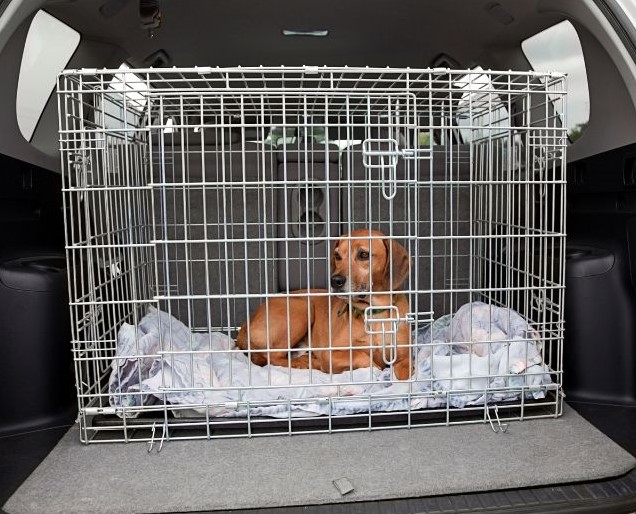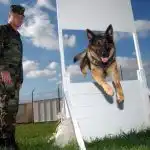Quick Start Guide to living with a high energy working dog:
Physical Exercise
Exercise is crucial for your working dog’s well-being, and it should be a part of your daily routine. To keep your pet active and healthy, we suggest daily walks with new smells, and two running sessions a week. It’s important to vary the types of exercise, as it will keep your pet engaged and interested. Check out our article by veterinarian Dr. Mohsin Iqbal, who explores the benefits of Socialization and Group Play to help release your dog’s physical energy and another on how Toys can help wear down the physical energy of your working dog. Also, learn about the best fitness trackers to monitor your dog’s physical exercise needs.
Mental Exercise
Highly intelligent working dog breeds require mental stimulation to reduce their endless energy and drive. Playing games, learning new tricks, practicing commands, playing with toys, and exploring new walks and smells can help release their mental energy. Check out our article on the 5 Best Tech Gadgets for Smart Working Dogs and the 10 Best Toys for Dogs With Anxiety. Also, read veterinarian Dr. Mohsin Iqbal’s article about the benefits of Playing with Toys, and another on Socialization and Group Play to help release your dog’s mental energy.
Obedience and Boundaries
Setting clear boundaries and enforcing them consistently is essential for working dogs. It builds trust and a bond with your dog and sets them up for success. Types of rules that can be set are; humans walk through doors first, no dogs on the couch, no dogs on the bed, or no dogs in the kitchen. It doesn’t matter which rules you decide to set, pick the ones that matter most for your lifestyle, but enforce them consistently. Learn more about this topic in How to Build Trust With Working Dogs and How To Make Your Dog Obedient – A Complete Guideline, both written by veterinarian Dr. Mohsin Iqbal.
Chewing
Chewing is a primal need for dogs, and it releases tension and stress that builds up in their neck and head. By training your dog to enjoy a long chewing session, you can help them manage their stress levels. Find the perfect chew toy for your energetic dog by checking out our exploration of the 6 Best Chew Toys for Energetic Dogs. Learn more about the effect of chewing in reducing stress in a working dog in veterinarian Dr. Mohsin Iqbal’s article.
Crating
Crate training is an excellent technique for calming highly energetic dogs. Once they are trained, your dog will have a comfortable and cozy place to go where they feel safe and can turn their brain off from the present and work through what they just experienced. It’s great to use after a walk or obedience session. Learn more about the importance of crate training in veterinarian Dr. Mohsin Iqbal’s deep dive into Crating your Working Dog. Also, check out our review The Best Dog Crate Equipment for Crate Training Your Puppy
By implementing these five points, you can significantly improve your working dog’s welfare and happiness. Don’t wait any longer; start today!
See below for a deeper dive into each.

Physical Exercise
As a dog owner, you know that your pet’s well-being is essential. Keeping your dog active and healthy is crucial for their physical and mental health. Exercise is a great way to achieve this goal, but it’s important to ensure that you provide your furry friend with the right type and amount of physical activity. In this article, we will explore the importance of physical exercise for working dogs, the types of exercise that are best for them, and how to keep track of your dog’s exercise routine.
Why is Physical Exercise Important for Working Dogs?
Working dogs, such as hunting or herding dogs, have been bred for specific tasks that require them to be physically active and alert. These dogs have high energy levels and need to engage in activities that can release their physical and mental energy. Regular exercise helps to keep their muscles toned, improves their cardiovascular health, and helps maintain their weight.
Physical exercise also has many mental health benefits for dogs. Exercise can help reduce anxiety and stress, improve their mood, and increase their overall happiness. It can also improve their cognitive function and make them more alert and responsive.
Types of Exercise for Working Dogs
There are many types of exercise that you can do with your working dog, and it’s essential to provide them with a variety of activities. Here are some examples:
Daily Walks: Taking your dog for a daily walk is an excellent way to keep them active and healthy. Make sure to take them to new places, so they can explore and experience new smells and sights.
Running: Running is another great way to keep your dog active. Two running sessions a week can be very beneficial for your pet. Start with shorter distances and gradually increase the duration and intensity of the exercise.
Swimming: Swimming is a low-impact exercise that can be very beneficial for dogs with joint issues. It’s also an excellent way to keep your dog cool during hot summer months.
Agility Training: Agility training is a fun way to keep your dog mentally and physically stimulated. It involves navigating through obstacles, such as tunnels, jumps, and weave poles.
Group Play: Socialization and group play can help release your dog’s physical energy. Dogs love to play and interact with other dogs, so taking your pet to a dog park or arranging playdates with other dogs can be very beneficial.
Monitoring Your Dog’s Exercise Routine
It’s essential to monitor your dog’s exercise routine to ensure that they are getting enough physical activity. Fitness trackers are a great way to monitor your dog’s exercise needs. These devices can track your dog’s steps, distance traveled, and calories burned.
Conclusion
Physical exercise is essential for your working dog’s well-being, and it should be a part of your daily routine. Regular exercise can help keep your pet active, healthy, and happy. By providing your dog with a variety of activities, you can ensure that they get the right type and amount of exercise. It’s also important to monitor your dog’s exercise routine to ensure that they are getting enough physical activity. With these tips, you can help keep your working dog fit and healthy for years to come.

Mental Exercise
As a dog owner, you may already know that physical exercise is vital for your pet’s well-being. But did you know that mental exercise is just as important for highly intelligent working dog breeds? Dogs with a lot of energy and drive require mental stimulation to keep them engaged and reduce boredom, which can lead to destructive behavior. In this article, we’ll explore the benefits of mental exercise for your working dog and suggest some ways to keep them mentally stimulated.
Playing games is one of the best ways to exercise your dog’s mind. Games such as hide-and-seek, treasure hunts, and puzzle toys require your dog to use their problem-solving skills and can be a lot of fun for both you and your pet. You can also practice teaching your dog new tricks, which is an excellent way to challenge their cognitive abilities and improve their bond with you. Dogs enjoy learning and thrive on positive reinforcement, so training sessions can be a great way to spend quality time together.
Practicing commands is another way to keep your dog’s mind active. Start with simple commands such as sit, stay, come, and down, and gradually increase the difficulty level. Dogs love to please their owners, so practicing commands can be a rewarding experience for them. You can also use interactive toys that require your dog to follow specific commands to access treats or rewards. This type of mental exercise can help improve your dog’s obedience and focus.
Exploring new walks and smells can also provide your dog with mental stimulation. Dogs have a keen sense of smell, and exploring new scents can be an exciting and stimulating experience for them. Taking different routes on your walks, visiting new parks, and allowing your dog to sniff around can provide a change of scenery and keep them mentally engaged.
In addition to games and walks, socialization and group play can help release your dog’s mental energy. Dogs are social animals, and playing with other dogs can provide them with valuable mental and social stimulation. Group play can help reduce anxiety, promote healthy socialization, and provide your dog with much-needed exercise.
Toys are also an essential part of your dog’s mental exercise routine. The right toys can keep your dog entertained for hours, help reduce anxiety, and stimulate their minds. Puzzle toys, chew toys, and interactive toys that dispense treats are all great options for mental exercise.
If you’re looking to take your dog’s mental exercise routine to the next level, check out our article on the 5 Best Tech Gadgets for Smart Working Dogs. From interactive cameras to automatic feeders, these gadgets can provide your dog with new and exciting ways to exercise their mind.
In addition, if you have a dog with anxiety, be sure to check out our article on the 10 Best Toys for Dogs With Anxiety. These toys are specially designed to provide comfort and stimulation for dogs who are prone to stress and anxiety.
In conclusion, mental exercise is just as important as physical exercise for highly intelligent working dog breeds. Playing games, learning new tricks, practicing commands, exploring new walks and smells, socialization and group play, and using the right toys can all help keep your dog mentally stimulated and engaged. By incorporating mental exercise into your dog’s daily routine, you can help reduce boredom, improve their behavior, and strengthen your bond with them.

Obedience and Boundaries
As a working dog owner, one of the most crucial aspects of their training is setting clear boundaries and enforcing them consistently. While it may seem like a challenge, setting boundaries is essential in creating a harmonious relationship between you and your dog. In this article, we’ll explore the importance of boundaries and obedience in working dogs.
Firstly, it’s important to understand that boundaries aren’t about restricting your dog’s freedom or being overly authoritarian. Instead, they’re about creating structure and setting expectations. This allows your dog to know what is expected of them and how they can behave in different situations. By having clear boundaries, you can help your dog feel more secure and reduce their anxiety levels.
When it comes to setting boundaries, it’s important to choose rules that are reasonable and that suit your lifestyle. For example, if you don’t want your dog on the couch, make it a rule that they are not allowed on the couch. If you want your dog to wait until you walk through a door first, make it a rule that they must wait for you to lead the way.
Enforcing these rules consistently is essential. If you allow your dog to jump on the couch one day but then scold them for doing the same thing the next day, it can create confusion for your pet. Be sure to follow through with the rules you set, and your dog will learn to respect them over time.
It’s important to note that while obedience training is crucial for working dogs, it shouldn’t be the only focus of their training. Your dog also needs mental and physical stimulation to remain happy and healthy. Playing games, practicing commands, exploring new walks, and socializing with other dogs can all provide mental stimulation and reduce their endless energy.
If you’re struggling to set boundaries or enforce them consistently, consider working with a professional dog trainer. They can help you identify the areas where your dog needs improvement and provide you with the tools you need to create a positive and productive relationship with your pet.
In conclusion, setting clear boundaries and enforcing them consistently is essential for working dogs. By doing so, you can help your dog feel more secure and reduce their anxiety levels. Remember to choose rules that are reasonable and enforce them consistently, and your dog will learn to respect them over time. And don’t forget to provide your dog with mental and physical stimulation to keep them happy and healthy.

Chewing
Dogs are known for their love of chewing, and it is a primal need that is hardwired into their DNA. Chewing is a great stress reliever for dogs, and it helps release tension and stress that builds up in their neck and head. This is especially important for working dogs who often have a lot of pent-up energy that needs to be released. By training your dog to enjoy a long chewing session, you can help them manage their stress levels and keep them calm and happy.
The benefits of chewing for dogs are numerous. Chewing helps keep their teeth clean and strong, provides them with mental stimulation, and helps reduce boredom and anxiety. In addition, chewing can be a great way to keep your dog occupied and out of trouble when you are not able to be with them.
Chewing on bones can be a natural and enjoyable activity for dogs, but it’s important for owners to understand the potential dangers and best practices. Bones can splinter and cause serious injury or blockages in the digestive system. Choose large, raw bones without added flavoring or seasoning. Always supervise your dog while they chew, and take the bone away once it has become small enough to be swallowed whole. It’s also a good idea to consult with your veterinarian to determine if bone chewing is appropriate for your dog’s individual needs and health concerns. With proper care and attention, bone chewing can be a safe and healthy activity for your furry friend.
When it comes to choosing the perfect chew toy for your energetic dog, there are a few things to keep in mind. First, you want to make sure the chew toy is safe and durable. Look for toys made from high-quality materials that can withstand your dog’s powerful jaws. Second, you want to choose a toy that is appropriate for your dog’s size and chewing habits. A toy that is too small can be a choking hazard, while a toy that is too big may not be as enjoyable for your dog to chew on.
To help you find the best chew toys for your energetic dog, we have compiled a list of the 6 Best Chew Toys for Energetic Dogs. Our list includes toys that are safe, durable, and designed to provide your dog with hours of chewing enjoyment.
In addition to providing your dog with the right chew toys, it is important to understand the effect of chewing on reducing stress in a working dog. Veterinarian Dr. Mohsin Iqbal has written an informative article on this topic, which provides valuable insight into the benefits of chewing for dogs.
In conclusion, chewing is a primal need for dogs, and it is essential for their mental and physical well-being. By providing your dog with the right chew toys and training them to enjoy a long chewing session, you can help reduce their stress levels and keep them happy and healthy. For more information on the best chew toys for energetic dogs and the benefits of chewing for working dogs, check out our resources and articles today.

Crating
As a dog owner, you want your furry friend to be happy and comfortable in their environment. But what happens when your energetic dog gets overwhelmed or anxious? Crate training is an excellent technique that can help calm your dog down and provide them with a safe and comfortable space to relax.
Firstly, it’s essential to understand what crate training is and how it works. Essentially, crate training involves teaching your dog to see their crate as a comfortable and safe place to relax. This is achieved by gradually introducing the crate to your dog and rewarding them for going in it. Over time, your dog will come to see the crate as a haven, where they can feel secure and calm.
But why is crate training so important for working dogs? Highly energetic dogs can easily get overwhelmed by their surroundings, and this can lead to anxiety, restlessness, and even destructive behavior. By providing your dog with a safe and cozy space to retreat to, you can help them manage their stress levels and reduce their anxiety.
In fact, crate training can be an effective tool for calming your dog down after a walk or obedience session. When your dog returns from a walk or training session, they may be feeling stressed or overwhelmed. By encouraging them to retreat to their crate, you give them a chance to calm down and process what they’ve just experienced.
But it’s important to remember that crate training is not a punishment. Your dog should never be forced into their crate or left there for extended periods. The crate should always be a place where your dog feels safe and secure.
If you’re interested in crate training your working dog, there are a few things to keep in mind. Firstly, you’ll need to choose the right crate for your dog’s size and temperament. The crate should be large enough for your dog to stand up, turn around, and lie down comfortably.
You’ll also need to introduce the crate to your dog gradually. Start by placing treats and toys inside the crate, and encouraging your dog to explore it on their own. Once your dog is comfortable with the crate, you can start to use it as a tool for calming them down.
To learn more about the benefits of crate training for working dogs, check out veterinarian Dr. Mohsin Iqbal’s deep dive into crating your working dog. If you are in the market for a new crate, check out The Best Dog Crate Equipment for Crate Training Your Puppy. With the right approach, crate training can be a valuable tool for helping your energetic dog manage their stress levels and feel more comfortable in their environment.
For more information about traits and behaviors of working dogs check out these articles by Veterinarian Dr Mohsin Iqbal:

Herding Dog Breeds – Traits and Behavior Problems
Herding dogs are the most versatile, with unique traits that make them perfect for herding livestock. While these dogs can make excellent pets, they exhibit certain troublesome behaviors that can be difficult to manage. Wondering why herding dogs have a higher propensity for behavior problems?

Guard and Military Dogs – Traits and Behavior Problems
Guard dogs are often misunderstood, and their behavior problems are commonly mishandled by dog owners. Gaining an understanding of the most frequent canine behavioral issues is key to solving them and preventing future ones. Have you ever wondered how poor pet management affects pet behavior?

Hunting Dog – Traits and Behavior Problems
Out of all dog breeds, hunting dogs have developed more problematic behaviors. These dogs are bred and trained to hunt; when they don’t perform as desired, they can become agitated and destructive. As a result, many pet owners find themselves struggling with these animals’ behavior. So, what are some of the most common problematic behavior issues among hunting dog breeds?
